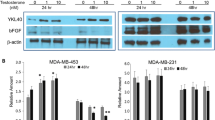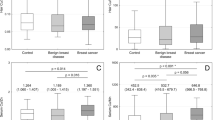Abstract
Gross cystic breast disease (GCBD) is one of the most common breast diseases, and women with apocrine (type I) cysts are at higher risk of developing breast cancer than women with flattened (type II) cysts. Type I cysts contain fluid with an electrolyte composition similar to that of intracellular fluid (Na/K ratio <3), whereas type II cysts fluid’s content resembles that of plasma (Na/K ratio >3). The electrolyte composition of breast cyst fluid (BCF) has been investigated intensively; however, there have been only a few studies in literature reporting the content of trace elements in BCF. The aim of this study was to compare the concentrations of Na, K, Ca, P, Zn, Cu, Fe, and Na/K and trace element ratios in breast cyst fluid in two subgroups of breast cysts. Sixty-three BCF were obtained by needle aspiration from premenopausal women with GCBD diagnosed by clinical, xheromammographic, and cytological studies. After separation of cells for cytological evaluation, the cyst fluid was centrifuged and supernatant stored at −80°C until the analysis. Sodium, potassium, calcium, phosphorus, and iron were measured using Roche Diagnostics commercial kits on Hitachi 747-200 autoanalyzer. Measurements of copper and zinc were performed by flame atomic absorption spectrophotometer on Shimadzu AAS 680. We found statistically significant higher K, lower Na, higher phosphorus concentrations, and lower Na/K ratios in type I cysts when compared with type II cysts’ values. Median values of Na/K ratio in type I and in type II were 0.32 and 6.2, respectively. Higher Zn, Cu, and Fe concentrations with respect to median values were noted in type I cysts; higher [Na.Cu/K.Zn], [Na.Cu/K.Fe], and [Na.Zn/K.Fe] ratios were found in type II cysts. A significant negative correlation existed between Na/K and Cu, and a significant positive correlation between Na/K and Fe in type II cysts (r = −0.660, p = 0.007; r = 0.615, p = 0.014, respectively). We can conclude that the trace elements content of BCF, in addition to electrolytes, could be useful in classifying the breast cyst. Future studies in larger series are needed to confirm these data.





Similar content being viewed by others
References
Forbes JF (1997) The incidence of breast cancer: the global burden, public health considerations. Semin Oncol 24:S120–S135
Morrison AS (1993) Screening for cancer of the breast. Epidemiol Rev 15:244–255
Ciatto S, Biggeri A, del Rosselli TM, Bartoli D, Iossax A (1990) Risk of breast cancer subsequent to proven gross cystic disease. Eur J Cancer 26:555–557
Haagensen CD, Bodian C, Haagensen DE (eds) (1981) Breast carcinoma, risk and detection. Saunders, London
Harrington E, Lesnick G (1980) The association between gross cysts of the breast and breast cancer. Breast 7:13–17
Bodian CA, Lattes R, Perzin KH (1992) The epidemiology of gross cystic disease of the breast confirmed by biopsy or by aspiration of cyst fluid. Cancer Detect Prev 16(suppl):95–103
Dixon JM, Lumsden AB, Miller WR (1985) The relationship of cyst type to risk factors for breast cancer and the subsequent development of breast cancer in patients with breast cystic disease. Eur J Cancer Clin Oncol 21:1047–1050
Miller WR, Scott WN, Phil M, Harris WH, Wang D (1992) Using biological measurements, can patients with benign breast disease who are at high risk for breast cancer be identified? Cancer Detect Prev 16(suppl):13–20
Bodian CA (1993) Benign breast diseases, carcinoma in situ, and breast cancer risk. Epidemiol Rev 15:177–187
Haagensen CD (1986) Diseases of the breast. Saunders, Philadelphia
Love SM, Gelman RS, Silen W (1982) Fibrocystic disease of the breast: a nondisease? N Engl J Med 307:1010–1014
Enriori CL, Novelli JE, Cremona MDC, Hirsig RJP, Enriori PJ (1992) Biochemical study of cyst fluid in human breast cystic disease: a review. Breast Cancer Res Treat 24:1–9
Dupond WD, Page DL (1985) Risk factors for breast cancer in women with proliferative breast disease. N Engl J Med 312:146–151
Lai LC, Erbas H, Lennard TWJ, Peaston R (1996) Prostate-specific antigen in breast cyst fluid: possible role of prostate-specific antigen in hormone-dependent breast cancer. Int J Cancer 66:743–746
Malatesta M, Mannello F, Sebastiani M, Cardinali A, Marcheggiani F, Reno F, Gazzanelli G (1998) Ultrastructural characterization and biochemical profile of human gross cystic breast disease. Breast Cancer Res Treat 48:211–219
Dogliotti L, Orlando F, Caraci P, Puligheddu B, Torta M, Angeli A (1990) Biochemistry of breast cyst fluid: an approach to understanding intercellular communication in the terminal duct lobular units. Ann NY Acad Sci 586:17–28
Miller WR, Dixon JM, Scott WN, Forrest AP (1983) Classification of human breast cysts according to electrolyte and androgen conjugate composition. Clin Oncol 9:227–232
Boccardo F, Valenti G, Zanardi S, Cerruti G, Fassio T, Bruzzi P, De Franchis V, Barreca A, Del Monte P, Minuto F (1988) Epidermal growth factor in breast cyst fluid: relationship with intracystic cation and androgen conjugate content. Cancer Res 45:5860–5863
Bradlow HL, Skidmore FD, Schwartz MK, Fleisher M, Schwartz D (1983) Cations in breast cyst fluid. In: Angeli A, Bradlow HL, Dogliotti L (eds) Endocrinology of cystic breast disease. Raven, New York, pp 197–201
Angeli A, Bradlow HL, Bodian CA, Chasalow FI, Dogliotti L, Hagensen DE (1990) Criteria for classifying breast cyst fluids. Ann NY Acad Sci 586:49–52
Belanger A, Caron S, Labrie F, Naldoni C, Dogliotti L, Angeli A (1990) Levels of eighteen non-conjugated and conjugated steroids in human breast cysts fluid: relationship with cyst type. Eur J Cancer 6:277–281
Lai LC, Cornell C, Lennard TWJ (1993) Relationship between oestrogen-inducible proteins, oestradiol and electrolyte ratio in breast cyst fluid. Cancer 24:668–675
Ness JC, Sedghinasab M, Moe RE, Tapper D (1993) Identification of multiple proliferative growth factors in breast cyst fluid. Am J Surg 166:237–243
Mannello F, Malatesta M, Gazzanelli G (1999) Breast cancer in women with palpable breast cysts. Lancet 354:677–678
Dixon JM, McDonald C, Elton RA, Miller WR (1999) Risk of breast cancer in women with palpable breast cysts: a prospective study, Edinburgh Breast Group. Lancet 353:1742–1745
Tsung JSH, Wang TY, Wang SM, Yang PS (2005) Cytological and biochemical studies of breast cyst fluid. Breast 14:37–41
Hindle WH, Arias RD, Florentine B, Whang J (2000) Lack of utility in clinical practice of cytologic examination of nonbloody cyst fluid from palpable breast cysts. Am J Obstet Gynecol 182:1300–1305
Mannello F, Tonti GAM, Papa S (2006) Human gross cyst breast disease and cystic fluid: bio-molecular, morphological, and clinical studies. Breast Cancer Res Treat 97:115–29
Boccardo F, Lunardi G, Guglielmini P, Parodi M, Murialdo R, Schettini G, Rubagotti A (2004) Serum enterolactone levels and the risk of breast cancer in women with palpable cysts. Eur J Cancer 40:84–89
Foote FW, Stewart FW (1945) Comparative studies of cancerous vs. non cancerous breasts. Ann Surg 121:6–53
Chasalow FI, Bradlow HL (1990) Digoxin-like materials in human breast cyst fluids. Ann NY Acad Sci 86:107–116
Chasalow FI, Blethen SL (1990) Characterization of digoxin-like materials in human cord serum. Ann NY Acad Sci 595:212–221
Weber CJ, Kim D, Costanzo M, Morris J, Howe B, Ward L, D’Agati V, McDonald T, O’Dorisio TM, Butler VP (1994) Relationship of Na and K concentrations to GRP, CGRP and calcitonin immunoreactivities and Na,K-ATPase inhibitory activity in human breast cyst fluid. Ann Surg Oncol 1:339–344
Sigel H (ed) (1980) Metal ions in biological system: carcinogenicity and metal ions, vol. 10. Marcel Dekker, New York
Sunderman FW Jr (1984) Recent advances in metal carcinogenesis. Ann Clin Lab Sci 14:93–122
Sky-Peck HH (1986) Trace metals and neoplasia. Clin Physiol Biochem 4:99–111
Naga Raju GJ, Sarita P, Ravi Kumar M, Ramana Murty GAV, Seetharami Reddy B, Lakshminarayana S, Vijayan V, Rama Lakshmi PVB, Gavarasana S, Bhuloka Reddy S (2006) Trace elemental correlation study in malignant and normal breast tissue by PIXE technique. Nucl Instrum Methods Phys Res B 247:361–367
Kubala-Kukuś A, Banaś D, Braziewicz J, Góźdź S, Majewska U, Pajek M (2007) Analysis of elemental concentration censored distributions in breast malignant and breast benign neoplasm tissues. Spectrochim Acta Part B 62:95–701
Rizk SL, Sky-Peck HH (1984) Comparison between concentrations of trace tlements in normal and neoplastic human breast tissue. Cancer Res 44:5390–5394
Siddiqui MKJ, Jyoti, Singh S, Mehrotra PK, Singh K, Sarangi R (2006) Comparison of some trace elements concentration in blood, tumor free breast and tumor tissues of women with benign and malignant breast lesions: an Indian study. Environ Int 32:630–637
Ebrahim M, Eltayeb MAH, Shaat MK, Mohmed Nader MA, Eltayeb EA, Ahmed AY (2007) Study of selected trace elements in cancerous and non-cancerous human breast tissues from Sudanese subjects using instrumental neutron activation analysis. Sci Total Environ 383:52–58
Bogdanova AY, Virkki LV, Gusev GP, Nikinmaa M (1999) Copper effects on ion transport across lamprey erythrocyte membrane: Cl−/OH− exchange induced by cuprous ions. Toxicol Appl Pharmacol 159:204–213
Li J, Lock RA, Klaren PH, Swarts HG, Schuurmans Stekhoven FM, Wendelaar Bonga SE, Flik G (1996) Kinetics of Cu2+ inhibition of Na+/K+-ATPase. Toxicol Lett 87(1):31–38
Ussing HH, Zerahn K (1951) Active transport of sodium as the source of electric current in the short-circuited isolated frog skin. Acta Physiol Scand 23:110–127
Handy RD, Eddy FB, Baines H (2002) Sodium-dependent copper uptake across epithelia: a review of rationale with experimental evidence from gill and intestine. Biochim Biophys Acta 1566:104–115
Martin F, Linden T, Katschinski DM, Oehme F, Flamme I, Mukhopadhyay CK, Eckhardt K, Troger J, Barth S, Camenisch G, Wenger RH (2005) Copper dependent activation of hypoxia-inducible factor (HIF)-1: implications for ceruloplasmin regulation. Blood 105(12):4613–4619
Brem S, Wotoczek-Obadia MC (1998) Regulation of angiogenesis by copper reduction and penicillamine: antagonism of cytokine and growth factor activity. AACR Special Conference: Angiogenesis and Cancer Research, Orlando, FL, 24–28 January
Hu GF (1998) Copper stimulates proliferation of human endothelial cells under culture. J Cell Biochem 69(3):326–335
Cousins RJ (2006) Zinc. In: Bowman BA, Russell RM (eds) Present knowledge in nutrition, vol 1, 9th edn. ILSI, Washington, DC, pp 445–457
Booy EP, Kadkhoda K, Johar D, Bay GH, Los M (2005) The immune system, involvement in neurodegenerative diseases, ageing and cancer. Curr Med Chem Anti-Inflamm Anti-Allerg Agents 4:349–353
Hashemi M, Ghavami S, Eshraghi M, Booy EP, Los M (2007) Cytotoxic effects of intra and extracellular zinc chelation on human breast cancer cells. Eur J Pharmacol 557:9–19
Bothwell TH, Charlton RW, Cook JD, Finch CA (1979) Iron metabolism in man. Blackwell Scientific, St. Louis, Oxford
Andrews NC (1999) Disorders of iron metabolism. N Engl J Med 341:1986–1995
Troccoli R, Stella F, Biagioni S, Battistelli S, Cerroni L, Marcheggiani F, Artico M, Terzano C, Mannello F (1990) Ferritin and transferrin levels in human breast cyst fluids: relationship with intracystic electrolyte concentrations. Clin Chim Acta 192(1):1–7
Acknowledgments
This study is supported by Dokuz Eylul University Research Fund (project no. 04.KB.SAG.067).
Author information
Authors and Affiliations
Corresponding author
Rights and permissions
About this article
Cite this article
Şişman, A.R., Sis, B., Canda, T. et al. Electrolytes and Trace Elements in Human Breast Cyst Fluid. Biol Trace Elem Res 128, 18–30 (2009). https://doi.org/10.1007/s12011-008-8253-1
Received:
Accepted:
Published:
Issue Date:
DOI: https://doi.org/10.1007/s12011-008-8253-1




